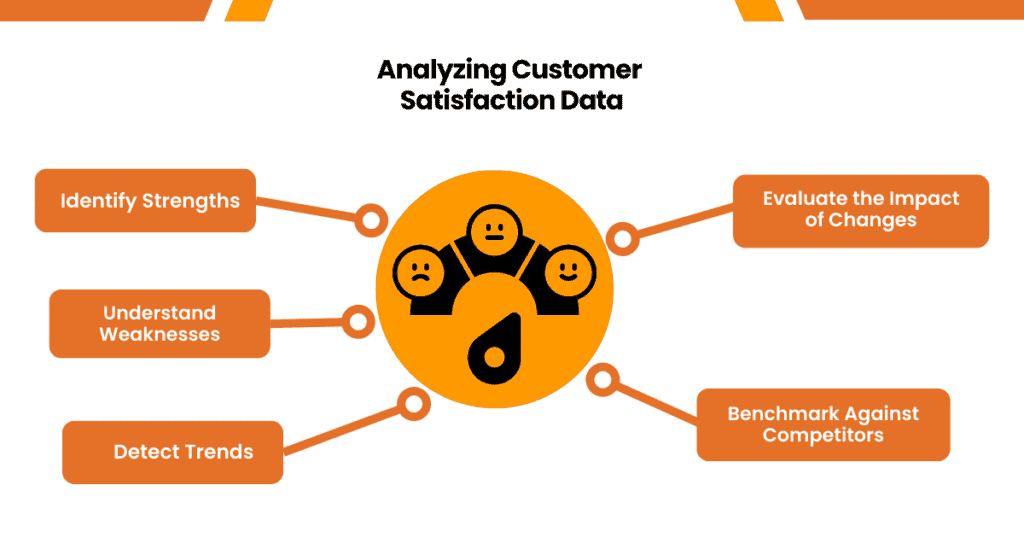Welcome to the next installment of our series aimed at helping franchise owners build a more customer-focused business. So far, we’ve explored the importance of customer-centricity and offered guidance on leadership and team-building strategies. Now it’s time to delve into how to measure success in terms of customer satisfaction.
Understanding and measuring customer satisfaction provides insights into how well your franchise meets customer expectations so you can make data-driven decisions that improve your business. Let’s examine how to measure customer satisfaction, essential KPIs to track, and tips for analyzing customer data.
How to Measure Customer Satisfaction
There are several ways to measure customer satisfaction, and employing more than one method can provide a more comprehensive view of how well you are meeting your customers’ needs. Here are some options to try.
Surveys

Surveys are among the most common and effective ways to measure customer satisfaction. They provide a systematic way to gather customer feedback and can be designed to capture specific information related to your franchise’s products, services, or overall customer experience.
You can employ several types of surveys to measure customer satisfaction:
- Transactional Surveys: These are typically conducted immediately after a transaction or customer interaction. The purpose is to gauge the customer’s satisfaction with that specific interaction. For example, a quick survey might be sent after a customer service call or once a product has been delivered.
- Periodic Surveys: These surveys are conducted at regular intervals, such as quarterly or annually, to assess the general satisfaction of your customer base over time. They are great for spotting trends, understanding the impact of any changes made in your business, and benchmarking against previous periods.
- Pulse Surveys: These are short surveys sent out more frequently to get a quick read on customer satisfaction. They often contain just one or two questions and help get immediate feedback on recent changes or issues.
Social Media Monitoring
In the digital age, customers often use social media to express their satisfaction or dissatisfaction with a brand. Monitoring your brand’s social media presence (via brand mentions and on your own social media pages) can help gauge customer satisfaction. Look for trends in comments and messages to see how customers perceive your brand.
Online Reviews
Online reviews are another valuable source of information for measuring customer satisfaction. Positive reviews indicate high customer satisfaction, while negative reviews can highlight areas for improvement. Check out our article here to learn about monitoring online reviews manually or using software.
Direct Interviews
Conducting direct customer interviews can provide deep insights into their satisfaction levels. While this method is more time-consuming and resource-intensive, it offers an opportunity to gather qualitative data and understand your customers’ needs and expectations deeper.
For more ideas, check out our article 9 Ways to Get Feedback from Customers. Although written for auto businesses, the methods discussed work for any industry.
Key Performance Indicators: Essential Metrics for Your Franchise

Before we dive into analyzing customer satisfaction data, it’s critical to understand the Key Performance Indicators (KPIs) relevant to customer satisfaction. KPIs are quantifiable measures that evaluate the success of an organization in meeting its strategic and operational goals.
Customer-centric KPIs provide a pulse on customer sentiment and can guide you in improving satisfaction and loyalty. By tracking these KPIs, you can better view your performance from the customer’s standpoint.
Here are some KPIs that every franchise owner should pay attention to:
- Customer Satisfaction Score (CSAT): This is a basic measure of satisfaction with your services or products. It’s typically measured by a short survey question after a transaction or interaction.
- Net Promoter Score (NPS): This measures the willingness of customers to recommend your products or services to others. It’s a strong indicator of overall customer experience and loyalty.
- Customer Effort Score (CES): This tracks how much effort customers have to put into getting their issues resolved. Lower effort typically leads to higher customer satisfaction.
- Customer Churn Rate: This measures the percentage of customers who stop doing business with you over a given period. A lower churn rate is a good sign of customer satisfaction.
- Customer Retention Rate: This is the opposite of the churn rate, measuring the percentage of customers who continue to do business with you over a given period. Higher retention rates indicate higher customer satisfaction.
- Customer Lifetime Value (CLV): This measures the total revenue you can expect from a single customer account. It considers both the revenue and the lifespan of the customer relationship.
These KPIs provide a comprehensive view of your franchise’s customer-centric performance. By regularly tracking these metrics, you can gain valuable insights into your customer satisfaction levels and make data-driven decisions to improve your strategies.
Analyzing Customer Satisfaction Data

Once you’ve collected your customer satisfaction data, the next step is to analyze it to glean actionable insights.
Identify Strengths
Start by identifying where your franchise excels. Look at areas where customers consistently express high levels of satisfaction. This could be a specific product, a particular service, or an aspect of your customer service process. Recognizing these strengths allows you to enhance these areas further and use them as benchmarks for other areas of your business.
Understand Weaknesses
Understanding your weaknesses is equally important as knowing your strengths. Look for areas where customers consistently express dissatisfaction. These could be specific products, services, or broader issues like wait times, unhelpful staff, or poor communication. Understanding these weaknesses allows you to improve and enhance your customers’ experiences.
Detect Trends
By analyzing customer satisfaction data over time, you can detect trends that might not be immediately apparent. Perhaps satisfaction dips at a particular time of year, or a new product line isn’t being received as well as expected. Identifying these trends allows you to address issues before they become more significant problems.
Evaluate the Impact of Changes
Use your customer satisfaction data to evaluate the impact of changes you make in your business, whether a new product, a change in process, or a new marketing strategy. If customer satisfaction improves, it indicates that the change is positive. If satisfaction declines, it may be necessary to reassess.
Benchmark Against Competitors
Finally, it can be helpful to benchmark your customer satisfaction levels against those of your competitors. This can give you an idea of where you stand in your industry and highlight areas to improve to stay competitive.
One More Stop on Our Journey

Measuring and tracking customer satisfaction is a compass that will guide you to building a more customer-focused franchise. By understanding your customers’ experiences and perceptions, you can make informed decisions that improve satisfaction and loyalty.
But our journey doesn’t end here—we have one more article in this series. In that final piece, we’ll share best practices for embracing a customer-focused approach in your franchise business. See you then!



